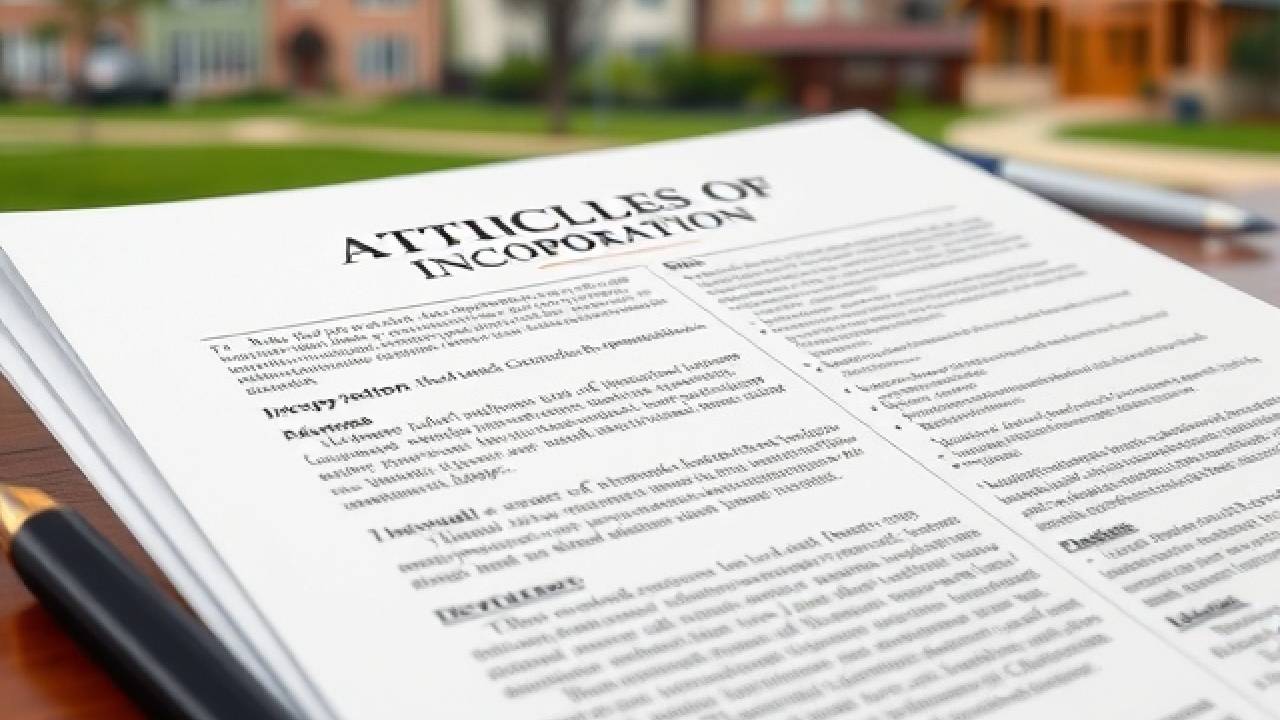In the vast expanse of legal and corporate documentation, the Lppoa Incorporation Documents standout as pivotal to understanding the fabric of how local property owner associations are structured and operate. These documents not only mark the birth of a legally recognized entity but also outline the initial visions and operational frameworks intended by its founders.
Historical traces change within these documents through years signify shifts in governance models and adaptability to new regulations and member needs. Interesting to note, approximately 75% of property owner associations have amended Lppoa Incorporation Documents within the past two decades, reflecting evolving community requirements and legal environments. This responsiveness is crucial for the sustainability and relevance of such associations in dynamic societal contexts.
Lppoa incorporation documents are essential formal records that establish the legal framework of a Local Property Owners’ Association. These documents outline critical operational guidelines, such as governance structure, financial management policies, and member rights and responsibilities, which are crucial for legal compliance and organizational efficiency.
Lppoa Incorporation Documents: A Brief Overview
Incorporation documents are like the birth certificate for the Local Property Owners’ Association (LPPOA). They officially record the creation of the association and detail its legal status. These documents serve as a foundational guide, outlining the rules, purposes, and structure of the association. They make it clear what the LPPOA is all about and how it is supposed to operate.
One of the main features of these documents is the Articles of Incorporation. These include critical information such as the LPPOA’s name, its main location, and the duration of its existence, which usually is perpetual. These articles lay the groundwork for all other operations and decisions. It’s this structured approach that helps in managing properties effectively.
Apart from the Articles, there are bylaws detailed in the Lppoa Incorporation Documents. Bylaws are basically the internal rules that govern the day-to-day operations of the LPPOA. These include procedures for elections, member meetings, and other vital administrative roles. Bylaws ensure that operations run smoothly and in a structured manner, without any confusion about procedural issues.
Overall, the LPPOA incorporation documents form the legal backbone of the association. They not only establish its legal identity but also provide clear instructions for management and operational procedures. Having these documents in order not only supports legal compliance but also boosts the confidence of property owners within the association.
Definition and Purpose of Incorporation Documents
Incorporation documents are official papers that legally establish an organization. When a property owners’ association like LPPOA decides to form, it has to create these documents. They serve as a formal declaration that the LPPOA is a recognized entity under the law. This is crucial for dealing with other businesses and the government.
The main purpose of these documents is not just to declare that the LPPOA exists. They also outline the main aims and objectives of the association. This includes management of communal properties, adherence to local property laws, and providing a structured environment for its members. Essentially, they set the direction for all the association’s activities.
Lppoa Incorporation Documents are divided into several parts, each with a specific role. For instance, the articles of incorporation include basic details about the LPPOA. This would be the official name, the principal address, and the type of legal entity it is. There might also be information about the board of directors and the scope of their powers.
Another crucial part of incorporation documents are the bylaws. These act as the operating manual for the LPPOA. Bylaws detail the rules about meetings, elections of officers, and other important procedures. They ensure that everyone knows how things should be done, promoting fairness and transparency within the association.
Key Components of Lppoa Incorporation Documents
The Lppoa incorporation documents are fundamental elements that make up the legal structure of the association. Here, the Articles of Incorporation play a central part. They officially state the establishment of the LPPOA and include essential details like the organization’s name, purpose, and the principal office’s location. This foundational section solidifies the LPPOA’s identity in legal terms.
Following the articles, the bylaws form another vital component. While the Articles of Incorporation set up the LPPOA, the bylaws outline how it will run. These rules cover meeting schedules, officer duties, voting procedures, and more. Bylaws work to ensure all members operate under a common set of guidelines, which helps in maintaining order and uniformity across the association’s activities.
Another critical section within the incorporation documents is the list of board members and their responsibilities. Since these individuals oversee the LPPOA’s operations, their roles have to be clearly defined to avoid any operational conflicts. This part also includes details on board elections, terms of service, and the protocol for replacing board members who leave.
Lastly, any amendments that have been made to the original documents are also an important component. Amendments can reflect changes in management practices, adjustments to compliance requirements, or shifts in the association’s goals. Keeping a record of these changes is crucial for legal transparency and helps members understand the evolution of their governance structure.
The Role of Incorporation Documents in Property Management
Lppoa Incorporation Documents do more than just establish a property owner’s association; they are key tools in managing property effectively. One major role these documents play is in defining the scope of the association’s responsibilities. This includes tasks like maintenance of communal areas, managing utilities, and enforcing community rules.
These documents also play a crucial role in financial management. They outline how dues and fees should be collected from members, how this money will be used, and under what circumstances the budget can be amended. This clear financial guideline helps in maintaining transparency and trust among the members.
Beyond financials, the incorporation documents set legal standards for the association. They include clauses that comply with local and federal law, ensuring that the association’s operations do not violate any regulations. This is crucial for managing legal risks and avoiding potential lawsuits that could harm the community financially.
The documents also aid in resolving disputes within the community. By referring to the written bylaws and articles, board members can handle conflicts fairly and uniformly. This helps in maintaining peace and order within the property, making it a better place for everyone to live.
Lastly, these documents are vital during transitions in board members or changes in management. They provide a record of the association’s foundation and rules, making it easier for new members to understand their roles and obligations quickly.
Overall, the incorporation documents of an LPPOA don’t just serve as formal paperwork. They act as a comprehensive guide for managing the day-to-day and legal aspects of community living. This ensures that property values are maintained and that residents enjoy a well-managed living environment.
Amendments in Lppoa Incorporation Documents over the Years
Over time, the Local Property Owners’ Association (LPPOA) incorporation documents have seen several important changes. Amendments are necessary to adapt to new laws, community needs, or improved management practices. These modifications help keep the association relevant and legally compliant.
One significant area of change has been in the governance structure. Originally set to manage smaller communities, the LPPOA’s bylaws and articles of incorporation were adjusted as the number of properties grew. This ensured that the association could handle increased responsibilities efficiently and effectively.
Another key update involved the rules regarding property modifications. As more homeowners showed interest in making changes to their properties, it became important to update the documents to address new types of property alterations. These amendments made sure that any changes made were in harmony with the community’s aesthetics and safety standards.
Financial management clauses have also been revised. This includes updates to how dues are collected and how funds are allocated. Being transparent about financial practices is crucial for maintaining trust among members, and these updates reflect a commitment to transparency.
- Adapting to new environmental regulations
- Updating privacy policies to protect members’ data
- Improving conflict resolution processes to ensure fairness
Each amendment reflects a response to a specific need or challenge within the community. By recording these changes, the LPPOA helps provide a clear historical trail of how it has evolved. This understanding fosters confidence and stability within the community membership.
Case Study: The Impact of Incorporation Documents on a Property Owner Association
Understanding the impact of incorporation documents on the Local Property Owners’ Association (LPPOA) can be seen clearly in a particular case study. This association faced significant management challenges and member dissatisfaction just a few years ago. By revisiting and amending their incorporation documents, they were able to address these challenges effectively.
Initially, the LPPOA struggled with unclear roles and responsibilities, leading to conflicts among board members and dissatisfaction among property owners. After conducting several meetings and consultations with legal advisors, they revised their bylaws to clarify and distribute responsibilities more logically. This modification alone greatly improved operational efficiency.
Another major issue was the collection and handling of association dues. Members were unclear about how funds were being used, which decreased their willingness to contribute. With amendments to financial management clauses in the incorporation documents, the LPPOA introduced a transparent reporting system. This system included detailed quarterly financial reports accessible to all members, which restored trust and improved fund collection rates.
The revisions also included updates to compliance with new environmental regulations. Previously, there were no clear guidelines, which occasionally put the association at risk for penalties. The updated documents included strict adherence to local environmental laws and guidelines, ensuring all community projects were compliant.
Most importantly, the impact of these changes on community satisfaction was profound. Membership approval ratings improved markedly, and the number of disputes dropped significantly. Residents felt more involved and assured that their interests were being managed correctly and transparently.
This case clearly illustrates how critical well-crafted incorporation documents are in the successful management of a property owners’ association. By addressing specific issues through amendments, the LPPOA not only solved longstanding problems but also paved the way for a more harmonious and efficient community.
Reflecting on the Importance of LPPOA Incorporation Documents
The exploration of LPPOA incorporation documents reveals their critical role in establishing and maintaining the legal and operational frameworks that underpin effective property management. These documents not only provide clarity and structure but also ensure compliance and facilitate smoother governance within property owner associations.
As community needs and legal requirements evolve, so must these documents. The periodic review and amendment of incorporation documents play a pivotal role in adapting to new challenges and opportunities, ultimately ensuring the longevity and success of the association.
FAQ:
What are Lppoa Incorporation Documents?
Lppoa Incorporation Documents are formal records that establish the legal framework of a Local Property Owners’ Association (LPPOA).
What does the LPPOA incorporation documents reveals?
The exploration of LPPOA incorporation documents reveals their critical role in establishing and maintaining the legal and operational frameworks that underpin effective property management.
What does the LPPOA incorporation documents reflicts?
The Lppoa Incorporation Documents reflects evolving community requirements and legal environments.







